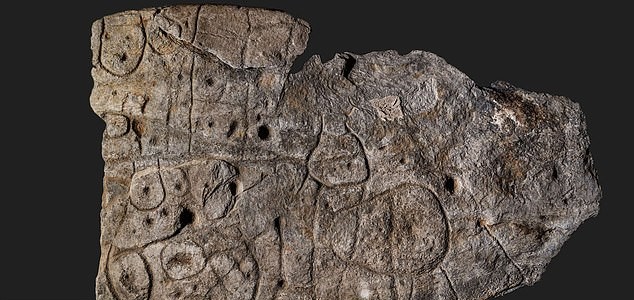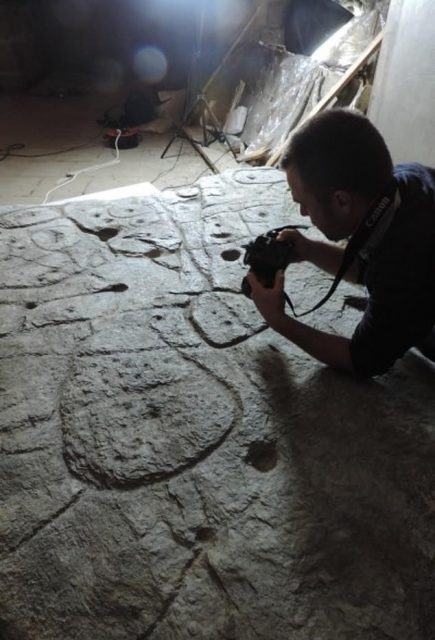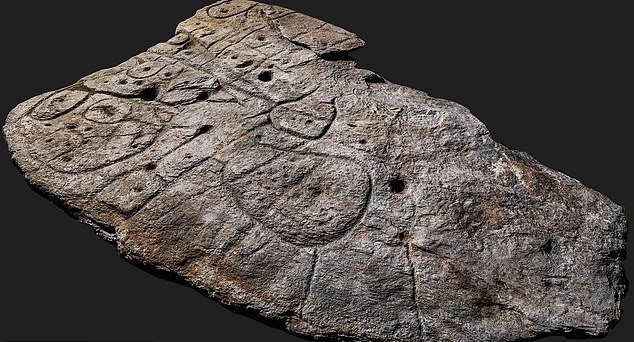Check out the oldest known map in Europe… though people might be forgiven for thinking it’s an ancient gravestone.
The Saint-Bélec Slab, 4,000 years old and measuring 5 by 6 ft, has been analyzed by a team from France and Britain. It bears mysterious symbols, engraved lines and raises shapes that suggest a deeper meaning.
Turns out it’s revealing a location surrounding the 39 mile long River Odet in Western France. At least that’s the thinking. As the Guardian writes, these “appear to resemble topographical features”.
Experts have noted parallels with prehistoric map layouts – the lines connect to various motifs, joining everything together in a coherent whole. The whole in question is believed to be Finistère, according to BBC News.
The Mail reports the ancient European map is “purposely 3D-shaped to represent the valley of the River Odet”. Water could be represented by the various lines. There’s a reported 80% match between what’s on the slab and the area it’s said to show.

Hi-res 3D surveys and photogrammetry were applied to the slab, the surface detail of which was recorded in depth. The unusual artifact has been spoken of since its initial discovery at the beginning of the 20th century.
Writing about the team’s study – published in the journal Bulletin of the French Prehistoric Society – the Mail says it could reveal a “hierarchical political entity that tightly controlled a territory” in the period. The time frame is believed to be the early Bronze Age (2150 – 1600 BC).
Historian Paul du Châtellier was the person who first found the broken Saint-Bélec Slab in 1900. At that point it “formed one of the walls of a stone-cist,” a Bournemouth University statement describes.
To be more precise, “a small stone coffin-like box used to hold the bodies of the dead”. This was part of the burial of the Saint-Bélec, where it apparently received its name. During this time the map faced inside the tomb area. Only the dead could view its contents.
It found a new home at a private museum, before going on to the Museum of National Antiquities a quarter of a century later.
After seeing out the remainder of the century in a castle moat’s niche, experts appear to have lost track of the slab. Then in 2014 a search came up trumps in the castle cellar.
Bournemouth University point out similarities between the Saint-Bélec slab and the mysterious artifact known as the Nebra sky disk from Germany.
Made of bronze and with a diameter of approx 30 cm, it got its name from the town of Nebra, near where its discovery took place. Originally thought to be from the Bronze Age, the disk is rated as a truly important find of the 20th century.
Astronomical in nature, the colorful disk is adorned with gold stars and symbols that appear to be representing the Sun or the Moon.

Put simply, this map depicts the heavens. But as the slab team are keen to illustrate, it also shows an understanding of cartography that’s overlooked by modern day analysis. The University’s Dr Clément Nicolas spoke to BBC News, saying people “tend to underestimate the geographical knowledge of past societies.”
Dr Nicolas reminds readers that there are various carved stone maps for experts to consult. While they are largely “just interpretations”, the slab is different. Dr Nicolas and co believe this is “the first time a map has depicted an area on a specific scale.”
Another Article From Us: Ancient Chinese Duke Loved Horses so was Buried with Them… Hundreds of Them!
These days maps are associated with paper and parchment. Intricately-rendered pieces to be unfurled across a desk or framed and mounted on a wall. The Saint-Bélec slab brings the world a bulky-looking but no less artful effort…
